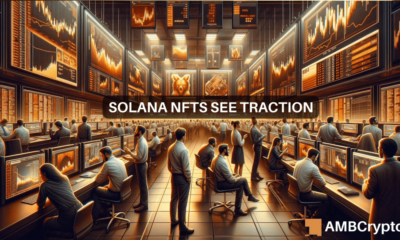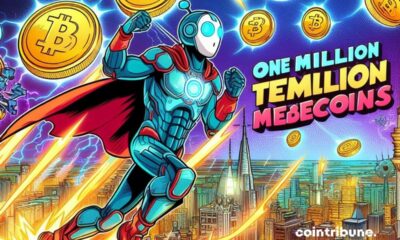NFTs
AI Hype, NFTs, And The PLCC Dilemma

Do retailers want shopper digital twins generated by AI from synthetic data? No.
getty
This week’s retail news held a lot of good news / bad news combinations. It is a continuation of the way things have been going in the industry since at least the beginning of the year, part of what is making it so difficult to get a solid read on consumer spending and how that is translating to retail results.
One new wrinkle is external factors, like how governments are responding to things like continued inflation or rising retail theft. Throw in a throwback to NFT’s
NFT
and the metaverse, which are maybe not as done as I thought they were, and you have this week’s twist and turns in the on-going journey into retail’s future. Let’s dive in!
Retail Economic Indicators
The biggest news of the week was the US Consumer Price Index (CPI), which came in hotter than expected. March 2024 CPI increased 0.4% over February, which had also unexpectedly increased 0.4% over January. At the time, February was written off as a possible outlier. Now that doesn’t seem as likely. Year over year, CPI increased 3.5% in March. One data point may not make a trend, but two could.
There was some good news in there – the food index increased only 0.1% over February, which is a place where consumers tend to really notice inflation. It was really shelter and gas prices that contributed the most to the rise, accounting for over half of the monthly increase. Energy increased 2.1% for the 12 months ending in March, which was the first increase in the year over year figure since February 2023. That’s not good news or bad news, other than that energy prices can be more volatile than other prices. But this read came in before Middle East politics got even more contentious, and that means there is likely more bad news here to come for April.
Retail sales, according to the CNBC/NRF Retail Monitor, grew “at a steady pace” in March. Retail sales were up 2.72% year over year (without any seasonal adjustment), and core retail, which excludes restaurants as well as autos and gasoline, was up 2.92%. As just noted, this was less than inflation, but not by too much. Across all of Q1, core retail sales were up 3.12%. The only thing to be careful of about this number, is that Easter fell in March this year, 9 days earlier than last year, so that “not seasonally adjusted” part actually is a big deal.
In the UK, the BRC-KPMG Retail Sales Monitor also found retail sales making steady progress. Year over year, retail sales were up 2.9%, and Q1 sales growth was overall up 2.1% year over year. Food sales did way better, growing 6.8% year over year in Q1. In comments on the results, the BRC pointed out that most of the growth came from Easter falling early, which means the results aren’t as great as they appear on the surface. Another case of what looks like good news, but maybe has some bad news embedded in the details.
The Federal Reserve Bank of Philadelphia reported on US account-based credit card delinquency rates for Q4 2023, and found that they were the worst they’ve seen since 2012. 3.5% of card balances were at least 30 days past due at the end of December. The share of accounts making minimum payments rose 34 basis points to a series high. About 10% of borrowers have balances greater than $5,200. However, about 1/3 of card holders pay their balance every month. Consumer savings built up over the pandemic seems to be gone. When that happened sometime late last year, the assumption was that consumers would pull back. They did not. Now, credit card limits available to consumers, or at least the disposable income available to pay off credit cards (which could impact discretionary spending) may finally be a dwindling available resource. Have consumers finally hit their limit? That’s the question we seem to keep asking.
Retail Tech & Research Data
In the land of consumer surveys and tech research, BazaarVoice released the results of a survey of 8,000 shoppers, including 2,000 US shoppers. They broke out some US-specific results in their Shopper Preference Report, focused on Return to Office (RTO) and the differences in shopping behavior vs. work from home (WFH). Of the 64% of US consumers that have returned to office, more than half are spending more money in physical stores vs. on online platforms, which is a significant difference against the overall average. I don’t know if this is because RTO shoppers now have less time to shop and so are more laser-focused and convenience oriented, or if it’s the temptation of browsing during the lunch hour. It’s an interesting statistic given how difficult it has been to get consumers to RTO, and the subsequent impact this has had on downtown shopping locations in particular.
Adyen publishes an Adyen Index Australia, in cooperation with the Centre for Economic Business Research (CEBR). They found that 43% of Australian retailers reported falling victim to cyber attacks or data leaks in the last year, which was a 10% increase over 2022. Australian retailers lost an average of AU$2.2 million to fraud in 2023. Only 67% of retailers surveyed said they had effective fraud prevention systems in place. And shoppers notice: 63% of Australian consumers say they feel more unsafe shopping today vs. 10 years ago, due to the increased risk of payment fraud. However, as a reminder, does that mean they are changing their shopping behavior as a result? Most likely not.
In the US, the NRF has been very active in lobbying for a greater crackdown on retail crimes, most especially organized retail crime. In the UK, it looks like the government is starting to put together a response to rising retail theft, organized or not. Some of the things that have been authorized: a standalone offence for assaults on retail workers, expanding the use of electronic monitoring for “prolific” shoplifters, including the greater use of facial recognition, and easier reporting of crime in order to catch more offenders, including enabling small businesses to upload video and photos from their mobile phones. Beyond facial recognition, the expansion also includes plans to consider GPS-monitored curfews and exclusion zones and greater use of technology to make it harder to sell stolen goods online. If an industry can’t fix its problems, then government will – often not necessarily to the industry’s liking. One interesting additional part of the crackdown includes a mandate to design to reduce theft, which could potentially be seen as going after cashierless stores, for example.
AI & Retail
I only came across one article worth mentioning about AI this week, and I really debated whether I was going to mention it at all. But I think it’s important to call out hyperbole as much as positive developments or risks. So I won’t link to it (it just seems piling on, somehow), but I will say that while there are some amazing things that AI can do, whether optimization or GenAI, there are also a lot of things that are required around AI before what it can do becomes useful.
For example, will we see an AI agent that will shop for you this year? We might see some proofs of concept or some pilots, but I highly doubt there will be any AI agent out there in 2024 that will have crossed the chasm into mainstream adoption where you give it some preferences or a description of what you’re looking for, and a budget, and it will go out and buy for you. I can’t even get Amazon to deliver dog food at the frequency I need and the company has perfect visibility into my demand pattern not just over months, but over years. I’ve tried “find it for me” agents in the past and the result has always been “meh”. Part of it may be the thrill of the hunt and losing out on that part of the experience. Part of it may be FOMO – that’s great that you found this cool thing, but what did the selection pool look like? And part of it may be a lack of transparency around the results themselves – why did you pick this thing? Which part of my criteria were you using the most (and do I need to tweak it)? That’s a lot to overcome in the next 8 months.
Will we see personalized storefronts driven by AI in 2024? No. And not because AI couldn’t come up with what needs to be personalized, but because you have to significantly componentize and attribute your website and all of your products to be able to actually execute on a recommendation like that, whether made by AI or otherwise. It’s one thing to reorder your search results to present a list of products in an order that is “personalized”. It’s another thing entirely to rebuild the order or emphasis of product description, ratings or reviews, product images, similar products, etc. I know this is hard because you don’t really need AI to do it if you wanted to, but you do have to have an eCom platform capable of supporting that kind of on-the-fly rebuild, either as the shopper logs in or as they spend more time on the site. And even if that existed today, most retailers are on older eCom solutions precisely because upgrading can be hard.
Will personalization get better with AI? Probably. I still maintain there is a huge difference between “personalized” and “relevant”. We have not achieved parity between the two, even with AI. AI might be good at divining patterns of behavior that swing the needle over more to “relevant” by being able to better identify context and timing impacts. But are retailers going to create and track shopper digital twins? That sounds like a PII (personally identifiable information) and privacy nightmare.
No retailer wants to know absolutely everything about a consumer, because that means they have to protect all that data. What retailers really want is the minimum amount of personal data required to increase your spend with them. A laugh out loud moment from the article that inspired this whole section: “Retailers and CPG brands already are experts at leveraging shopper analytics and purchase data to present consumers with personalized offers and coupons.” Cry-laughing, seriously. Some of them are getting better, but I’ll just mention that within the same article, the author pointed out that we still live in a land where online ads continue to follow you around for things you already bought. Yes, experts indeed.
I will give one point of credit. AI to summarize reviews is indeed here. And what’s fascinating to me is to point this out to non-industry friends and family, and have them know exactly what I’m talking about (Amazon’s review summaries are great), and still miss the fine print underneath that says the summary was generated by AI. They use it, they like it, they don’t even know how it came to be – and it’s useful, so they don’t really care. Summarization of just about anything is an excellent use of GenAI, and I expect we’ll see more of that in 2024.
But how do you know when AI commentary is total hype? Try this quote: “Using predictive synthetic data, a retailer could predict that a shopper who buys Starbucks ground coffee at Safeway on a Tuesday is also likely to buy Kerrygold butter in the same shopping trip – and could, for example, send them a mobile coupon while they’re in the store. And since synthetic data is anonymized, they could do this without compromising consumer privacy.”
So much to unpack. If the shopper is already likely to buy the butter, why send a coupon for it, first of all? And AI platforms are talking about synthetic data because they’ve already run out of human-generated data of any quality to include in the creation of their LLM’s. Retailers should not be using synthetic data for anything except diluting their results. And why would you need to anonymize synthetic data? It’s made up. That’s the point. There better not be any PII in there because it is supposed to be generated data that only looks like real personal data. You use synthetic data (theoretically – no one has proven that this is not actually “the computer science equivalent of inbreeding”) to create models. You use your own real-world data to train the model. You should not be mixing the two.
Finally, there was this nugget: “Retailers, facing stiff competition and operating on razor-thin margins, have always been early adopters of futuristic technologies.” I completely and utterly disagree. Retail is famous for being laggard technology adopters. The last twenty-five years have been a ringside seat to consumers adopting technology at a far faster pace than retailers, and watching retailers figure out what to do about it. I still encounter retailers who don’t want to give their store associates mobile devices because they are “distracting” and “get in the way of selling”. It is those razor-thin margins that exactly create an anti-innovation environment. Retailers can’t afford to take big risks. They don’t have the margin to cover the nine misses that are required to get that one innovative hit. Some are fast followers. But when it comes to innovation, that’s as close as you’re going to get.
Retail Winners and Losers
Yes, I just said that in general, retailers are not innovative. The economics of the industry are stacked against them when it comes to taking big, innovative risks. However, not all retailers are laggards when it comes to adopting something new. One immediate example: Wow Bao. The Asian fast-casual restaurant has been experimenting with NFT and metaverse crossovers. The company has tied them into its “Hot Buns Club” rewards program. The metaverse experience is in Roblox, where Wow Bao is hosting a Dim Sum Palace, complete with a DJ and a dance floor, as well as exploratory areas within the building, including the Steam Lounge and a speakeasy. Hidden inside the club is a free avatar head accessory. If they connect their Roblox account to their loyalty account, they can claim the accessory as a digital item, along with getting entered to win free bao for a year and receiving a “CollectaBao” NFT. Starbucks also recently revamped their NFT program – basically switching platform providers – so I guess there is enough activity out there to keep a loyalty ecosystem alive, at least.
And, as another proof point around the dangers of generalization, probably the next biggest news of the week was the announcement of a new innovation collaboration (W23 Global Venture Fund) between retail giants Tesco, Ahold Delhaize, Woolworths Group, Empire Company Ltd (Sobeys), and Shoprite. This global effort will focus on start-ups and “scale-ups” that will enhance customer experiences in store and online. Tesco alone will contribute the equivalent of $25 million over five years. This news comes on the heels of announcements in 2023 that retailers like Walmart and Target were scaling back on innovation labs or their equivalent.
These kinds of investments come and go in a periodic cycle, and this venture fund announcement probably signals the kick-off to the next round of investing. The challenge with these funds is getting the innovation back into the enterprise. Setting up a separate entity helps keep “we already tried that” out of the house, but it also makes it harder to spur adoption back into the funding enterprise. $5 million per year is chump change to someone like Tesco, and yet even if you multiply by 5, that’s definitely not enough to fund the next AI unicorn or anything. We shall see!
Finally, we’ll wrap with a topic that I would argue is not innovative at all: private label credit cards (PLCC). However, I will be the first to admit that I don’t really understand them. My closest experience with PLCC was in the dimming days of Montgomery Wards. I was a consultant at the time, working a project for Wards. The company had just sold off its PLCC business, in what was possibly the last ditch effort to get enough cash to last through the transformation its leaders were trying to implement. But without that cash cow, there was nothing left – the real estate was gone, the brand cachet was gone, and now this last profit center was gone. The technology was so old they couldn’t even find spare parts for the hardware any longer, and rooms full of aging Cobol programmers declared that they didn’t see anything wrong with the spaghetti of tech that ran the business – and was incapable of running on anything else.
So, intrinsically I knew losing the PLCC business was bad, no matter what price they got for it, and I knew that likely the reason why it made money was because its consumers were poor and paid late often and racked up high interest rates. Fast forward to today, interest rates are high, but they’re high because core rates are high. PLCC makes money on fees – the kind of fees that President Biden has made a point of targeting. On May 14, late fees will be capped at $8 per month (compared to an average of $32 today).
This is expected to squeeze department stores, which rely heavily on PLCC. Specialty retailers will feel the pinch too, but it’s expected that department store will really take the hit, as their revenue is already under pressure from more careful consumer spending. Macy’s and Nordstrom’s average 3% of revenue from their PLCC programs. Kohl’s, Macy’s, and Target all reported falling credit card revenue for 2023/24. With the rise of Buy Now Pay Later, is this the end of PLCC? Certainly, any consumers looking to save money are going to eye the 29.33% average interest rate on a retailer issued card vs. the average of 20.75% across all US credit cards. It could be the future is more about paid loyalty programs – with Target launching a paid tier to its Circle program, it will be interesting to see if the Red Card credit card business goes to the wayside as a result.
The Bottom Line
The amount of oxygen being sucked up by AI hype is starting to make people dizzy, and that’s not a good thing for retailers trying to figure out where to invest. Beware people hawking shiny objects – from the early days of my time at RSR we believed in and emphasized pragmatism over hype. Retailers can’t afford to take big risks. Even Nike, perennially tagged as an innovator, is still eating crow over its decision to de-emphasize wholesale, and saw its sales tank as a result. Their apology tour continues.
That said, I’m always happy when something that seems like it could be pretty cool – like NFT-based loyalty programs that tie into virtual experiences – outlasts its oxygen deprivation phase. And I think the more that industry experts, yes like me too, help outline exactly where to look for benefits, the easier it will be to persuade companies to take more (more informed) risks.
It’s needed. Consumers aren’t going to wait around. They expect technology as part of their shopping experience, and they expect a seamless experience however they choose to engage. Now, if we could just figure out what those pesky consumers are going to do next, then we could be better prepared to support their expectations.
Wait, isn’t that what AI is supposed to do?
Note: this article has been updated to clarify the report published by the Federal Reserve Bank of Philadelphia on US account-based credit card delinquency rates.
NFTs
Non-Fungible Items; Picking Up Where NFTs Left Off — COZ Co-Founder Tyler Adams – Op-Ed Bitcoin News

https://news.google.com/./articles/CBMiZmh0dHBzOi8vbmV3cy5iaXRjb2luLmNvbS9ub24tZnVuZ2libGUtaXRlbXMtcGlja2luZy11cC13aGVyZS1uZnRzLWxlZnQtb2ZmLWNvei1jby1mb3VuZGVy LXR5b GVyLWFkYW1zL9IBAA?hl=en-US&gl=US&ceid=US%3Aen
Fuente
NFTs
https://news.google.com/./articles/CBMiKmh0dHBzOi8vd3d3LmJiYy5jb20vbmV3cy9idXNpbmVzcy02NzI5NTc4NtIBLmh0dHBzOi8vd3d3LmJiYy5jb20vbmV3cy9idXNpbmVzcy02NzI5NTc4 Ni5hbXA?hl=en-US&gl=US&ceid=US%3Aen

https://news.google.com/./articles/CBMiKmh0dHBzOi8vd3d3LmJiYy5jb20vbmV3cy9idXNpbmVzcy02NzI5NTc4NtIBLmh0dHBzOi8vd3d3LmJiYy5jb20vbmV3cy9idXNpbmVzcy02NzI5NTc4 Ni5hbXA?hl=en-US&gl=US&ceid=US%3Aen
Fuente
NFTs
AI-Powered Discovery Network for NFTs Launches $PULSR Token – Press Release Bitcoin News

https://news.google.com/./articles/CBMiVGh0dHBzOi8vbmV3cy5iaXRjb2luLmNvbS9haS1wb3dlcmVkLWRpc2NvdmVyeS1uZXR3b3JrLWZvci1uZnRzLWxhdW5jaGVzLXB1bHNyLXRva2VuL9IBAA?hl= en -US&gl=US&ceid=US%3Aen
Fuente
NFTs
Solana Monkey Business Leads NFT Sales with $875,91K


Image: AI-generated via Midjourney
Solana Monkey Business topped CryptoSlam’s non-fungible token (NFT) sales charts on July 22 with $875,914 in total sales.
The collection had 122 unique buyers, equaling the number of sellers, and an average price of $5,308 per NFT.
This increase in daily sales boosted the SMB’s all-time sales volume to a new record of $212.48 million.
The Solana-based ape-themed collection entered the list of the top 30 NFT sellers of all time over the weekend, knocking SATS BRC-20 NFTs off the rankings.
The second best performing collection of the day was gETH Locked Deposit.
This NFT, which represents gETH locked on the Ethereum layer-2 network Arbitrum, saw a daily sales volume of $583,047 from just one transfer.
The asset was brother-in-law just moments before the transfer is made.
In third place, DMarket’s NFTs and in-game virtual items on the Mythos Network saw a total of $565,002 in sales.
The collection attracted 3,254 unique buyers and 2,848 sellers, with an average price of $24.66 per item. Active DMarket owners stood at 5,111, contributing to a total owner count of 397,931.
Outside of the top three, Ethereum’s DogeZuki Collection came in fourth place with $436,787. Bored Ape Yacht Club, another Ethereum collection, had total sales of $341,576 for fifth place.
While a Solana collection led the day’s results, the network’s total NFT sales for the day were slightly outpaced by Ethereum.
Ethereum led all blockchains in sales on Monday with $4.2 million, with Solana close behind at $4.1 million.
-

 Videos3 months ago
Videos3 months agoMoney is broke!! The truth about our financial system!
-

 News2 months ago
News2 months agoMore Crypto AI Alliances Emerge Following $7.5 Billion Token Merger — TradingView News
-

 Altcoins2 months ago
Altcoins2 months agoRender vs. Theta; Which DePIN Altcoin to buy in May
-

 Videos2 months ago
Videos2 months agoFantom: Potential FTM Price and BIG Updates – The Latest!!
-

 News2 months ago
News2 months agoOver 1 million new tokens launched since April
-

 Videos2 months ago
Videos2 months agoRecession soon?? What this means for you and your wallet!!
-

 NFTs3 months ago
NFTs3 months agoSurprisingly, Bored Apes is now laying off employees as the NFT market disintegrates
-

 NFTs2 months ago
NFTs2 months agoSolana NFTs jump 30% in 24 hours: what’s behind the increase?
-

 Memecoins2 months ago
Memecoins2 months agoSolana Dev hospitalized with third-degree burns while trying to pump Meme Coin
-

 Videos3 months ago
Videos3 months agoCryptocurrency Market Update: Where Are We NOW?! What’s next?
-

 Memecoins2 months ago
Memecoins2 months agoWhen memecoins reign supreme in the ecosystem!
-

 Videos2 months ago
Videos2 months agoCrypto News: ETH ETFs, Pro-Crypto Politics, UNI, DOGE & MORE!










